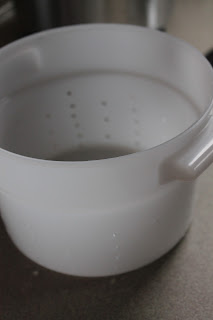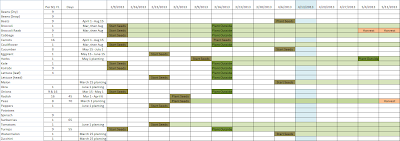I'd also purchase the cheesemaking kit to get started - it'll give you all of the ingredients and supplies that you'll need. You can also purchase them separately on Amazon or New England Cheesemaking, which is pretty much the authority on cheese making. Oh, and if I can say one important thing - cheesemaking does take a block of time. Most of it is non-active time, but you do have to make sure you are paying attention and setting a timer. It takes me about 3 1/2 to 4 hours from start to finish, and then there is the pressing time. Make sure you plan accordingly, as there is nothing worse than having to set an alarm for 2:30 in the morning so that you can take the cheese out of the press. Not that I know what that's about.
Today, I'm going to show you a quick little step-by-step of how I made my most recent cheese - a Drunken Cow Cheese. I've had a Drunken Goat cheese before, and I'm very much looking forward to this one. It's a washed curd cheese, which means literally that - the cheese curds are washed with fresh water, as opposed to just staying in their own natural whey. This will lower the overall acidity of the cheese. (Don't worry - I know I'm throwing around a lot of terms, but it'll all make sense if you read through the book.) This is not necessarily a tough recipe, but it might be easier to start with a recipe where you don't have to wash the curds. I'll be honest though - I've done both now and I find them both about the same in difficulty. You just have to make sure you're following the directions.
Did you know you can make cheese with milk from the grocery store? You can use any form of cow's milk, as long as it isn't Ultra-pasteurized. Or you can use raw milk, provided you let it age at least 60 days.
One of the most important parts of cheesemaking is maintaining a certain temperature for a certain period of time. This is probably one of the most important parts, as certain cultures react differently at certain temperatures. This is the thermometer that was included in my cheesemaking kit, and it actually works pretty well. (although I've since upgraded to a digital one.)
Another important thing is the pot. I have a heavy Calphalon stock pot that holds the same temperature for at least 60 minutes, so it's worked perfectly for me.
So once you get the temperature to where it needs to be, you let it sit for awhile, until it has a "clean break." To me, that just means it's gets sort of jello-like and you can cut it with a knife and it holds it's shape nicely. When that happens, you can then move onto the next step, which is probably one of my favorites. Cutting the curd is when you take a sharp knife and actually cut the gelled cheese mixture into squares. The book explains it extremely well and I found it so easy to do. Look at how pretty the little squares are!
Then you slowly heat the curds, which allows them to release some of the whey, which is the clear liquid on top that you see here.
For a washed curd cheese, you scoop out this whey and replace it with clean hot water a few times, hence "washing the curds!"
It'll then go into the press and will come out looking nice and compact.
After a few hours of some air drying, it'll take a lovely little wine bath for a total of 48 hours. Ours took on the most delicious dark red color, although it still looks very light here.
And then it goes into the cellar for about 3 months. If you don't have a cheese cave like ours, here's a great post for other options. The Drunken Cow cheese is on the top right. And don't worry - that's not mold - it's salt residue from the brine.
And there you go! I can't wait to crack into this cheese! I'll have to update the post once we do! And if you've tried your hand at cheesemaking, I'd love to hear how it turned out!
Drunken Cow Cheese
2 gallons whole milk
1/8 tsp Mesophilic direct set culture
1/8 tsp Calcium Chloride, diluted in 1/4 cup unchlorinated water
1 tsp liquid rennet, diluted in 1/4 cup unchlorinated water
1 tablespoon cheese salt (or good quality sea salt)
6 cups water, heated to 175 degrees F
1 bottle dark red wine (i used a Merlot)
Pour milk into large pot. Add the diluted Calcium Chloride and stir well. Heat the milk to 90 degrees F and stir in the mesophilic culture. Cover and allow to sit for 10 minutes. Add the diluted rennet and stir for one minute. Cover and let set for 60 minutes, maintaining the temperature. If your pot does not hold heat as well as mine, you can immerse the pot in a sink of 90 degree water. You will probably have to periodically add hot water to the sink to maintain the temperature.
Insert a knife and see if you have a clean break. If so, you can cut the curds into 1/2" cubes. Stir gently for about a minute and then cover and let them rest.
With a sterilized measuring cup, take out about 1/3 of the whey. (this was about 2.5 cups total for me). Gradually add the heated water and stire to bring the temperature of the curds up to 92 degrees. (Again, this was about 2.5 cups for me). Stir continuously so that curds don't clump together. Once they reach 92 degrees, let them rest for another 10 minutes, stirring occasionally. Drain off whey to the top of the curds using the measuring cup again. Continue to add heated water until the curd temperature is 100 degrees. Rest for 15 minutes, keeping at the target temperature and stirring occasionally to prevent clumping. Let the curds sit for 30 minutes at 100 degrees.
Pour curds into a cheesecloth-lined colander. Pour the curds back into the pot and break into 1/4" pieces with your fingers. Blend in the salt.
Pack the curds into a cheesecloth lined mold. Cover the curds with the cloth and press at 20lbs for 20 minutes. Remove the cheese from the press, unwrap and flip over. Rewrap cheese and place back into mold. Press again at 20lbs for 20 minutes. Remove, flip, rewrap, and place cheese back into press and press again for 20lbs for 12 hours.
Remove cheese from the mold and cheesecloth. Skewer 10 holes in each side of the cheese, going about halfway down each time. Bathe the cheese in wine for 24 hours, making sure the cheese is completely covered in wine and flipping halfway through. Remove, lay on a sushi mat for 6 hours, until dry to the touch. Repeat the wine bath again for 24 hours. Remove and allow to air dry until dry to the touch. (This took about 8 hours for me)
Store the cheese in your cheese cave (or wherever you age your cheese) at around 50 degrees F at about 85% humidity for three months. (For our cave, we just have a container of water in the bottom of the fridge and it keeps it nice and moist. Or check out this post for other DIY cheese cave ideas)
Turn cheese daily for about 2 weeks. Wipe down with a brine solution (a nice heavy salt water) if mold starts to form on the surface. (which is perfectly normal and okay - I had to keep telling myself this)





































